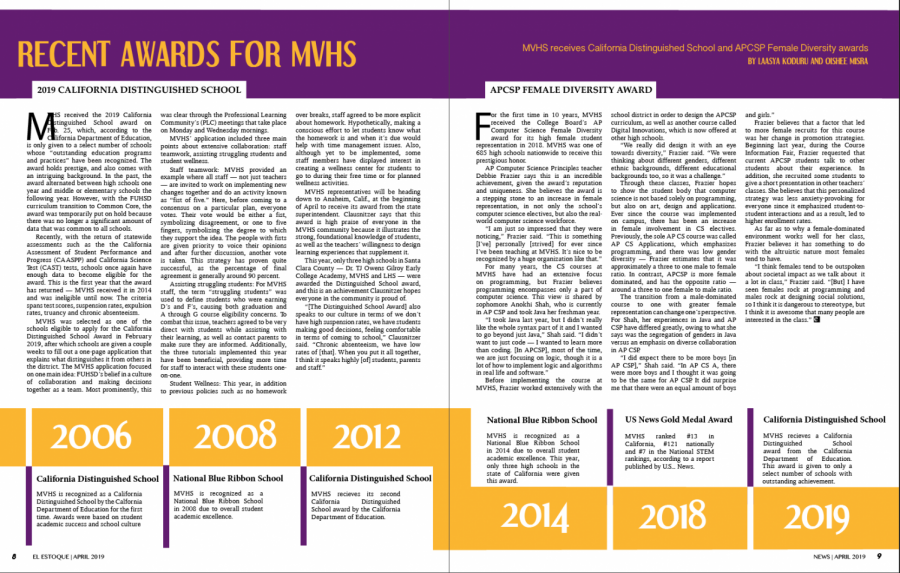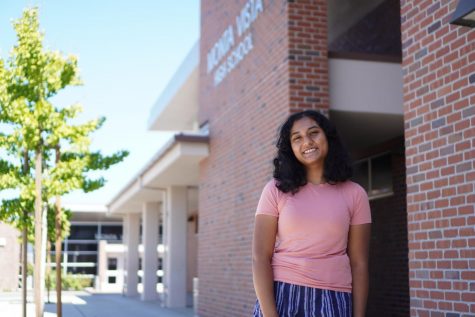Recent Awards for MVHS
April 10, 2019
2019 CALIFORNIA DISTINGUISHED SCHOOL
MVHS received the 2019 California Distinguished School award on Feb. 25, which, according to the California Department of Education, is only given to a select number of schools whose “outstanding education programs and practices” have been recognized. The award holds prestige, and also comes with an intriguing background. In the past, the award alternated between high schools one year and middle or elementary schools the following year. However, with the FUHSD curriculum transition to Common Core, the award was temporarily put on hold because there was no longer a significant amount of data that was common to all schools.
Recently, with the return of statewide assessments such as the the California Assessment of Student Performance and Progress (CAASPP) and California Science Test (CAST) tests, schools once again have enough data to become eligible for the award. This is the first year that the award has returned — MVHS received it in 2014 and was ineligible until now. The criteria spans test scores, suspension rates, expulsion rates, truancy and chronic absenteeism.
MVHS was selected as one of the schools eligible to apply for the California Distinguished School Award in February 2019, after which schools are given a couple weeks to fill out a one-page application that explains what distinguishes it from others in the district. The MVHS application focused on one main idea: FUHSD’s belief in a culture of collaboration and making decisions together as a team. Most prominently, this was clear through the Professional Learning Community’s (PLC) meetings that take place on Monday and Wednesday mornings.
MVHS’ application included three main points about extensive collaboration: staff teamwork, assisting struggling students and student wellness.
Staff teamwork: MVHS provided an example where all staff — not just teachers — are invited to work on implementing new changes together and do an activity known as “fist of five.” Here, before coming to a consensus on a particular plan, everyone votes. Their vote would be either a fist, symbolizing disagreement, or one to five fingers, symbolizing the degree to which they support the idea. The people with fists are given priority to voice their opinions and after further discussion, another vote is taken. This strategy has proven quite successful, as the percentage of final agreement is generally around 90 percent.
Assisting struggling students: For MVHS staff, the term “struggling students” was used to define students who were earning D’s and F’s, causing both graduation and A through G course eligibility concerns. To combat this issue, teachers agreed to be very direct with students while assisting with their learning, as well as contact parents to make sure they are informed. Additionally, the three tutorials implemented this year have been beneficial, providing more time for staff to interact with these students one-on-one.
Student Wellness: This year, in addition to previous policies such as no homework over breaks, staff agreed to be more explicit about homework. Hypothetically, making a conscious effort to let students know what the homework is and when it’s due would help with time management issues. Also, although yet to be implemented, some staff members have displayed interest in creating a wellness center for students to go to during their free time or for planned wellness activities.
MVHS representatives will be heading down to Anaheim, Calif., at the beginning of April to receive its award from the state superintendent. Clausnitzer says that this award is high praise of everyone in the MVHS community because it illustrates the strong, foundational knowledge of students, as well as the teachers’ willingness to design learning experiences that supplement it.
This year, only three high schools in Santa Clara County — Dr. TJ Owens Gilroy Early College Academy, MVHS and LHS — were awarded the Distinguished School award, and this is an achievement Clausnitzer hopes everyone in the community is proud of.
“[The Distinguished School Award] also speaks to our culture in terms of we don’t have high suspension rates, we have students making good decisions, feeling comfortable in terms of coming to school,” Clausnitzer said. “Chronic absenteeism, we have low rates of [that]. When you put it all together, I think it speaks highly [of] students, parents and staff.”
APCSP FEMALE DIVERSITY AWARD
For the first time in 10 years, MVHS received the College Board’s AP Computer Science Female Diversity award for its high female student representation in 2018. MVHS was one of 685 high schools nationwide to receive this prestigious honor.
AP Computer Science Principles teacher Debbie Frazier says this is an incredible achievement, given the award’s reputation and uniqueness. She believes the award is a stepping stone to an increase in female representation, in not only the school’s computer science electives, but also the real-world computer science workforce.
“I am just so impressed that they were noticing,” Frazier said. “This is something [I’ve] personally [strived] for ever since I’ve been teaching at MVHS. It’s nice to be recognized by a huge organization like that.”
For many years, the CS courses at MVHS have had an extensive focus on programming, but Frazier believes programming encompasses only a part of computer science. This view is shared by sophomore Anokhi Shah, who is currently in AP CSP and took Java her freshman year.
“I took Java last year, but I didn’t really like the whole syntax part of it and I wanted to go beyond just Java,” Shah said. “I didn’t want to just code — I wanted to learn more than coding. [In APCSP], most of the time, we are just focusing on logic, though it is a lot of how to implement logic and algorithms in real life and software.”
Before implementing the course at MVHS, Frazier worked extensively with the school district in order to design the APCSP curriculum, as well as another course called Digital Innovations, which is now offered at other high schools.
“We really did design it with an eye towards diversity,” Frazier said. “We were thinking about different genders, different ethnic backgrounds, different educational backgrounds too, so it was a challenge.”
Through these classes, Frazier hopes to show the student body that computer science is not based solely on programming, but also on art, design and applications. Ever since the course was implemented on campus, there has been an increase in female involvement in CS electives. Previously, the sole AP CS course was called AP CS Applications, which emphasizes programming, and there was low gender diversity — Frazier estimates that it was approximately a three to one male to female ratio. In contrast, APCSP is more female dominated, and has the opposite ratio — around a three to one female to male ratio.
The transition from a male-dominated course to one with greater female representation can change one’s perspective. For Shah, her experiences in Java and AP CSP have differed greatly, owing to what she says was the segregation of genders in Java versus an emphasis on diverse collaboration in AP CSP.
“I did expect there to be more boys [in AP CSP],” Shah said. “In AP CS A, there were more boys and I thought it was going to be the same for AP CSP. It did surprise me that there were an equal amount of boys and girls.”
Frazier believes that a factor that led to more female recruits for this course was her change in promotion strategies. Beginning last year, during the Course Information Fair, Frazier requested that current APCSP students talk to other students about their experience. In addition, she recruited some students to give a short presentation in other teachers’ classes. She believes that this personalized strategy was less anxiety-provoking for everyone since it emphasized student-to-student interactions and as a result, led to higher enrollment rates.
As far as to why a female-dominated environment works well for her class, Frazier believes it has something to do with the altruistic nature most females tend to have.
“I think females tend to be outspoken about societal impact as we talk about it a lot in class,” Frazier said. “[But] I have seen females rock at programming and males rock at designing social solutions, so I think it is dangerous to stereotype, but I think it is awesome that many people are interested in the class.”




























